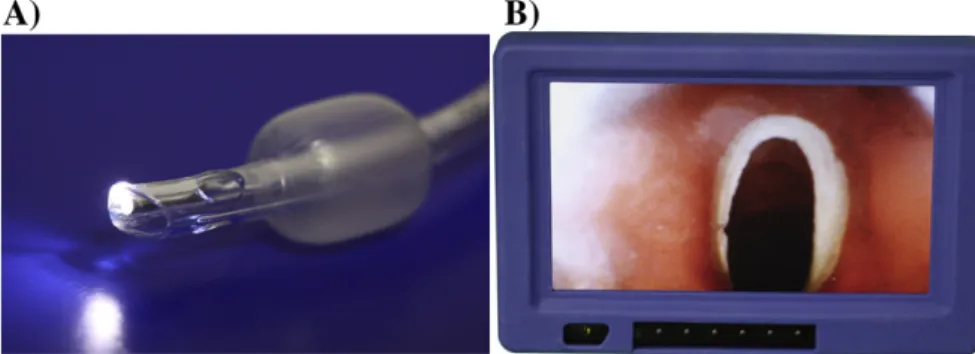Comparison of the VivaSight single lumen endotracheal tube and the Macintosh laryngoscope for emergency intubation by experienced paramedics in a standardized airway manikin with restricted access: a randomized, crossover trial☆
To the Editor,
Airway management is one of the key skills required by para-medics[1,2]. The standard for definitive airway management is direct laryngoscopy and endotracheal intubation (ETI). The most common method of intubation is the aforementioned direct laryngoscopy using a laryngoscope with Miller or Macintosh blades. However, getting a good glottis visibility using direct laryngoscopy in patients trapped in the vehicle can be problematic[2]. Therefore, it seems reasonable to search for alternative methods of intubation of patients. In those situations, it may be helpful to use videolaryngoscopes[3]or video tubes[2,4]. An example of video tube is the ETView VivaSight-SL (ETView; ETView Ltd, Misgav, Israel), which is a single-lumen airway tube with an integrated high-resolution imaging camera[2](Fig. 1).
We hypothesized that the ETView could be an alternative to standard direct laryngoscopy (MAC) during intubation of adult manikins trapped in vehicles. In the present study, we compared the time to intubation, success of intubation attempt and dental compression rate of ETView and MAC intubation with restricted access to the patient's face.
This open, prospective, randomized, crossover, not-blinded man-ikin study was approved by the institutional review board of the International Institute of Rescue Research and Education (Approval: 12.2015.08.32 on August 23, 2015). With voluntary written informed consent, 45 staff paramedics participated in this study, each with about 50 tracheal intubations' worth of experience in patients but no experience with video tube intubation.
Each participant performed orotracheal intubations on a SimMan manikin (Laerdal, Stavanger, Norway) which was trapped in a car. Intubation was performed with access through the open driver's door (reclining the seat was not allowed). Prior the study, all participants completed a 30-minute training session including an introduction to the anatomy and physiology of the airway and the techniques of endotracheal intubation using direct and video-laryngoscopy. An ETView SL with 7.0 mm internal diameter lubricated with silicon aerosol was used. For direct laryngoscopy participants used a standard laryngoscope with a no. 3 Macintosh blade (HEINE Optotechnik, Munich, Germany) and a standard 7.0 internal diameter endotracheal tube (Covidien, Mansield, MA),was also lubricated. A semirigid stylet was inserted in the tracheal tube when intubation was performed with the Macintosh and ETView. During intubation using ETView was not used to help standard laryngoscope, semi-rigid stylet introduced to ETView was only used. The study was designed as a randomized crossover trial to minimize learning effects (Fig. 2).
Forty-five paramedics (31 male; 68.9%) were enrolled. All participants worked in Emergency Medical Service teams in Poland. Mean age was 34.2 ± 9.4 years, and mean work experience was 9.4 ± 4.7 years.
The median time to intubation (TTI) with the ETView was 21.7 (interquartile range [IQR] 19-25) seconds, which was significantly shorter than TTI using MAC 37 (IQR, 30.6-48) seconds. The success rate after thefirst attempt using the ETView and MAC varied and amounted to 100% vs 86.7%. The results with ETView were
☆ Source of support: No sources of financial and material support to be declared.
significantly better than with the MAC (P b .05) for success of the first attempt, dental compression, and ease of intubation (Table 1).
In conclusion, in our simulation manikin trial, ETView helps paramedics to intubate a trauma patient in an interrupted in-car with restricted access scenario in less time and with fewer attempts than with the classical Macintosh laryngoscope, with access through an open driver's door of the car.
Conflict of interest statement None to declare.
Acknowledgement
We would like to thank all participating paramedics.
Zenon Truszewski, PhD, MD Łukasz Szarpak PhD, DPH, EMT-P* Department of Emergency Medicine Medical University of Warsaw, Warsaw, Poland ⁎Corresponding author at: Department of Emergency Medicine, Medical University of Warsaw, Lindleya 4 Str., 02-005 Warsaw, Poland Tel.: +48 500186225 (Mobile) E-mail address:lukasz.szarpak@gmail.com Jacek Smereka, PhD, MD Department of Emergency Medical Service Wroclaw Medical University, Wroclaw, Poland
Andrzej Kurowski, PhD, MD Department of Anesthesiology, Cardinal Wyszynski National Institute of Cardiology, Warsaw, Poland Togay Evrin, PhD, MD Department of Emergency Medicine, UFuK University Medical Faculty, Ankara, Turkey Łukasz Czyzewski, PhD, RN Department of Nephrologic Nursing, Medical University of Warsaw, Warsaw, Poland http://dx.doi.org/10.1016/j.ajem.2016.02.054
References
[1] Carlson JN, Karns C, Mann NC, E Jacobson K, Dai M, Colleran C, et al. Procedures performed by Emergency Medical Services in the United States. Prehosp Emerg Care 2016;20(1):15–21.http://dx.doi.org/10.3109/10903127.2015.
929 Correspondence /American Journal of Emergency Medicine 34 (2016) 903–932
Fig. 2. Flow chart of design and recruitment of participants according to CONSORT statement.Fig. 2 Fig. 1. The VivaSight single-lumen endotracheal tube (A) and view obtained through video tube (B).Fig. 1
Table 1
Data from intubation with access through the opened driver's door scenario.
Parameter assessed MAC ETView P
TTI (s) 37 (30.6-48) 21.7 (19-25) b.001
Overall success rate (%) 45 (100%) 45 (100%) NS
Success rate offirst attempt (%) 39 (86.7%) 45 (100%) .014 Dental compression N 5 (11.1%) 43 (95.5%) .011 1 37 (82.2%) 2 (4.5%) 2 3 (6.7%) -3 - -Ease of intubation 4 (3.5-6) 2.5 (2-3) .006
Data reported as median (IQR) or number (%); NS, not statistically significant.
[2] Truszewski Z, Szarpak L, Czyzewski L, Evrin T, Kurowski A, Majer J, et al. A comparison of the ETView VivaSight SL against afiberoptic bronchoscope for nasotracheal intubation of multitrauma patients during resuscitation. A randomized, crossover, manikin study. Am J Emerg Med 2015;33(8):1097–9.http://dx.doi.org/10.1016/j.ajem.2015.04.078. [3] Ruetzler K, Imach S, Weiss M, Haas T, Schmidt AR. Comparison offive video
laryngoscopes and conventional direct laryngoscopy: investigations on simple and simulated difficult airways on the intubation trainer. Anaesthesist 2015;64(7): 513–9.http://dx.doi.org/10.1007/s00101-015-0051-5.
[4] SzarpakŁ, Truszewski Z, Kurowski A, Czyzewski Ł, Evrin T, Bogdanski Ł. Tracheal intubation with a VivaSight-SL endotracheal tube by paramedics in a cervical-immobilized manikin. Am J Emerg Med 2016;34(2):309–10.http://dx. doi.org/10.1016/j.ajem.2015.10.013.
